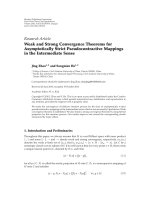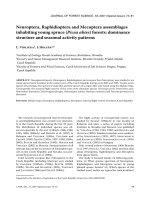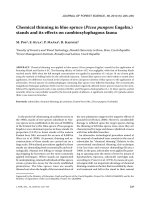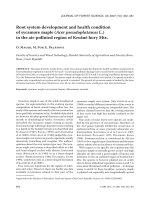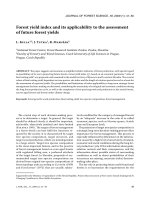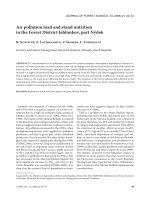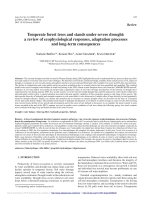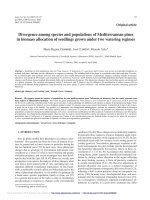Báo cáo lâm nghiệp: "Picea glauca dynamics and spatial pattern of seedlings regeneration along a chronosequence in the mixedwood section of the boreal forest" potx
Bạn đang xem bản rút gọn của tài liệu. Xem và tải ngay bản đầy đủ của tài liệu tại đây (416.53 KB, 6 trang )
789
Ann. For. Sci. 61 (2004) 789–794
© INRA, EDP Sciences, 2005
DOI: 10.1051/forest:2004079
Original article
Picea glauca dynamics and spatial pattern of seedlings regeneration
along a chronosequence in the mixedwood section
of the boreal forest
Tala AWADA
a
*, Geoffrey M. HENEBRY
b
,
Robert E. REDMANN
c
, Hari SULISTIYOWATI
c
a
School of Natural Resources, University of Nebraska-Lincoln, 12 D Plant Industry, Lincoln, NE 68583-0814, USA
b
Center for Advanced Land Management Information Technologies (CALMIT), School of Natural Resources,
University of Nebraska-Lincoln, 113 Nebraska Hall, Lincoln, NE 68588-0517, USA
c
Department of Plant Sciences, University of Saskatchewan, Saskatoon, SK S7N 5A8, Canada
(Received 9 May 2003; accepted 6 February 2004)
Abstract – We studied Picea glauca dynamics in the boreal forest of Saskatchewan, Canada, using 35 stands ranging from < 1 to > 200 y after
fire. We determined the spatial pattern and the importance of seedbed conditions to the recruitment of P. glauca. Basal area increased along the
chronosequence peaking at 110 y after fire (51.5 m
2
ha
–1
). The ratio of softwood to hardwood increased from 0.03 (16 y) to 17.0 (172 y). Picea
glauca tree density increased with stand age, highest densities were observed in a 172 y stand (1413 stems ha
–1
). Picea glauca dominated the
canopy between 93 and 172 y after fire. Picea glauca snags appeared about 66 y after fire, and remained relatively low in density until 160 y.
Saplings were present at varying densities along the chronosequence. Seedlings established immediately after fire and exhibited bimodality with
lowest densities observed between 110 and 125 y. Analysis with Ripley’s K, showed that seedlings were mainly distributed at random in young
stands but were clumped at a distances < 12 m in old stands. In young stands, the majority of seedlings regenerated on the organic layer (LFH
73%), while recruitment was almost exclusively on logs in old stands (94%). Picea glauca regeneration depended on propagule availability and
seedbed characteristics at early stand age. Logs and the resultant canopy gaps formed, appear to be critical for P. glauca regeneration in mature
and old stands.
Picea glauca / boreal forest / stand dynamics / spatial pattern / Ripley’s K
Résumé – Dynamique de Picea glauca et répartition spatiale de la régénération selon une chronoséquence située dans une zone de forêt
mélangée de la forêt boréale. Nous avons étudié la dynamique de Picea glauca en forêt boréale du Saskatchewan au Canada, en utilisant
35 peuplements dont l’âge va de 1 à 200 ans après incendie. Nous avons étudié la répartition spatiale des semis et mis en évidence l’importance
des conditions du milieu de germination pour la régénération de Picea glauca. La surface terrière augmente au cours de la chronoséquence,
avec un pic à 110 ans après incendie (51,5 m
3
par ha). Le rapport bois résineux sur bois feuillu s’accroît de 0,03 (16 ans) à 17,0 (172 ans) exprimé
en surface terrière. La densité de tiges de Picea glauca augmente avec l’âge du peuplement, la plus forte étant observée dans un peuplement de
172 ans (1413 tiges/ha). Picea glauca occupe une place dominante dans le couvert entre 93 et 172 ans après incendie. On voit apparaître des
Picea glauca morts sur pied, environ 66 ans après incendie ; ceux-ci restent peu nombreux jusqu’à 160 ans. On constate la présence de jeunes
individus, en nombre plus ou moins grand, tout au long de la chronoséquence. Les semis s’installent aussitôt après incendie. Ils sont
particulièrement denses à 50 et à 172 ans, avec un minimum entre 110 et 125 ans. L’analyse, à l’aide de la fonction de Ripley’s K, montre que,
dans les jeunes peuplements, les semis sont répartis au hasard, alors que dans les peuplements âgés, ils sont groupés par bouquets distants de
moins de 12 m. Dans les jeunes peuplements, la majorité des semis se développement sur la couche de matière organique du sol (73 %) alors
que dans les vieux peuplements ils ne se développement presque exclusivement que sur les arbres tombés au sol, en voie de décomposition
(94 %). La régénération de Picea glauca dépend de la disponibilité en semence viable et des conditions du lieu de germination, dans les jeunes
peuplements. Pour les vieux peuplements, ce sont les bois au sol et les trous qui en résultent dans le couvert qui dont déterminants.
Picea glauca / forêt boréale / dynamique des peuplements / répartition spatiale / Ripley’s K
1. INTRODUCTION
White spruce (Picea glauca (Moench) Voss) is one of the
most widely distributed conifers in North American boreal for-
est. White spruce extends from Alaska, where it is the dominant
species in the Brooks Range at the northern treeline [14] to
Newfoundland in the east and from the treeline south to Mon-
tana and the New England States [1]. Fire is the major natural
ecological factor controlling structure, function and composi-
tion in the western boreal forest of Canada [17]. The change in
* Corresponding author:
790 T. Awada et al.
structure of boreal forest along a chronosequence after distur-
bance has been described by Bergeron and Dansereau [6],
Jarvis et al. [23], Rowe [34], Thorpe [36] and Viereck [39],
among others. The speed of tree regeneration following distur-
bances depends on many factors including seed availability,
disturbance type, and seedbed characteristics [17]. In general,
on mesic sites in the mixedwood section of the boreal forest,
the shade intolerant, fast-growing trembling aspen (Populus
tremuloides (Michx.)) and other deciduous hardwoods regen-
erate readily following disturbance and quickly dominate the
canopy [5]. On sites where the organic layer has been removed,
white spruce (Picea glauca (Moench) Voss) seedlings may
establish if seeds are available [24]. Any established white
spruce seedlings are usually overtopped by aspen and remain
for decades in subordinate position until canopy gaps are
formed [28]. During the this period (around 80 y, [24]), trem-
bling aspen dies back and white spruce is released from the
understory, assuming dominance in the stand. Elliot-Fisk [11]
lists some of the environmental changes that take place along
the chronosequence in the boreal forest in response to canopy
closure. These include an increase in thickness of the organic
layer or the LFH (Litter, Fermented and Humus layers), and
decreases in available nutrients, soil temperature, and soil
drainage, resulting in anaerobic conditions and an increase in
frost heave and thrust.
The mixedwoods are the most productive and managed sec-
tions in the boreal forest ecosystems [8]. In the last two decades,
there has been a rapid move to using ecosystem based
approaches that mimic natural stand dynamics in forest man-
agement and restoration in the boreal forest [19]. To mimic nat-
ural stand dynamics, it is essential to understand the ecology
and dynamics of boreal species. While there is a rich body of
literature on the survival and seedbed characteristics of boreal
species like black spruce (Picea mariana) and jack pine (Pinus
banksiana) [18], there has been little comparable work done on
the recruitment, spatial distribution and seedbed preferences of
P. glauca [7], the most widely distributed and economically
important conifer in North American boreal forest. In this
paper, our objectives are to describe the population dynamics
of white spruce through extensive sampling of trees, saplings,
seedlings, and snags following fire in the mixedwood section
of the boreal forest. Further, we quantitatively characterize the
spatial pattern of seedlings and the importance of seedbed con-
ditions to the success of recruitment and survival of white
spruce along a 200 year chronosequence.
2. METHODS
2.1. Study area
The study area was located in the mixedwood section of the south-
ern boreal forest of Saskatchewan, Canada. The area falls between 53°
38’ and 54° 41’ N latitude, and 105° 00’ and 106° 20’ W longitude.
The climate is cool continental, characterized by long cold winters
and short warm summers. Monthly average temperatures vary from
–20 °C in January to 17 °C in July and the annual average precipitation
is around 450 mm [4] with approximately 70% falling as rain from
June through August [20]. Soils are mainly orthic gray luvisols and
brunisolic gray luvisols; a more detailed description of soil character-
istics is provided by Thrasher-Haug [37]. The vegetation on mesic
sites is dominated by white spruce (Picea glauca (Moench) Voss), bal-
sam fir (Abies balsamea (L) Mill), trembling aspen (Populus tremu-
loides Michx), balsam poplar (Populus balsamifera L.) and paper
birch (Betula papyrifera Marsh.). Important understory species are
bunchberry (Cornus Canadensis L.), twin flower (Linnea borealis L.),
sarsaparilla (Aralia nudicaulis L.), bishop’s cap (Mitella nuda L.) and
dewberry (Rubus pubescens Raf.) [4, 37]
With the use of forest inventory and topographic maps, 35 stands
were selected in and around the Prince Albert Model Forest (PAMF),
a member of the Canada Model Forest Network. PAMF encompasses
315 000 ha in the mixedwood section of the boreal forest. PAMF
includes land situated within a National park, a reserve land, and a
Crown land. The selected stands spanned a chronosequence ranging
from less than one year to 201 y after fire. Stand selection was based
on topography, soil characteristics, time since fire, and species com-
position. Time since fire was estimated by measuring ages of the larg-
est overstory white spruce and aspen and/or taken directly from for-
estry records (for more details see Thrasher-Haug [37]).
2.2. Picea glauca population dynamics
In each stand, a 40 m × 20 m plot was established and further
divided into 32 quadrats of 5 m × 5 m. Tree density (height > 4 m)
and diameter at breast height (dbh, cm) of the dominant tree species
(Picea glauca, Populus tremuloides and Abies balsamea) were
recorded, and basal area was calculated. White spruce (P. glauca) tree
height was measured with an Abney hand level [22]. Picea glauca sap-
ling (height 0.5–4 m), seedling (height < 0.5 m), and snag (standing
dead; height > 4 m) densities were also recorded.
2.3. Spatial analysis and seedbed characteristics
Using the quantitative results from the 35 stands, regression analysis
were performed and nine representative plots of the average species
composition for a specific stand age were chosen for the detailed sampling
of P. glauca seedling pattern: younger (5, 16, 43 y) (the 43 y old plot
did not have any seedlings and therefore was not included in the spatial
analysis), mature (76, 77, 93 y) and older (157, 172, 201 y) stands. The
locations of all seedlings were mapped, and substrate characteristics
next to each seedling were recorded; specifically, whether the seedling
was found on the LFH (Litter, Fermented, Humus layers), on decom-
posing logs, or on mineral soil. At each plot, the LFH thickness was
measured at the center of each 5 × 5 m quadrat (32 readings per plot).
Ripley’s K function second-order analysis was used to characterize
the spatial patterns of the mapped seedlings. Ripley’s K function [32,
38] tallies the number of occurrences within a given distance (t) across
a range of distances available within the sampling area. For a spatially
random Poisson process, K(t) = πt
2
. K can be estimated ( ) by this
function that includes edge correction [9]:
(1)
where a is the area of the sample plot; w
ij
is a weighing factor used
for edge effect correction (w
ij
= 1 when the circle centered on i with
a radius t lies totally within a, otherwise it is inversely proportional to
the circle circumference that lies within the plot); I
t
(i,j) is a counter
and is equal to 1 when the distance between i and j is less than t and
0 otherwise; and n is the number of occurrences in a. A variance-sta-
bilizing transform of makes it easier to evaluate deviations from
Poisson randomness:
.(2)
Plotting L(t) against distance t produces a straight line with a slope 1
when the point distribution is random. Deviations from such a line can
be described as clumped, random or even, for any distance t up to
approximately half the length of the shortest plot side [9, 30]. Significance
K
ˆ
),(/)(
ˆ
2
jiIwnatK
t
n
i
n
j
ij
∑∑
≠
=
K
ˆ
π
/)(
ˆ
)( tKtL =
Picea glauca dynamics in the boreal forest 791
of L(t) is determined using simulations of the randomized data sets [38].
Using S-Plus, empirical confidence interval envelopes were estab-
lished as the maximum and minimum values of L(t) from 10
3
simulations.
L(t) values exceeding the envelopes are considered non-random:
slopes larger than the confidence interval indicate clumped distribu-
tion and slopes smaller than the confidence interval indicate a more
even distribution.
3. RESULTS
3.1. Basal area
Basal area along the chronosequence increased in the first
50 y after fire, and showed little directional change between 50
and 165 y, peaking at 110 y after fire (51.5 m
2
ha
–1
), before
started to decline in old stands (24.4 m
2
ha
–1
in a 201 y stand)
(Fig. 1). During the period between 50 and 165 y, stands shifted
from being deciduous to coniferous dominated. The ratio of
softwood to hardwood basal area increased from 0.03 in a 16 y
stand to 17.0 in a 172 y stand. Populus tremuloides constituted
96% of the total basal area in a 16 y stand and remained the dom-
inant tree species until 93 y. Picea glauca dominated the tree
canopy between 93 and 172 y coinciding with increasing
P. tremuloides mortality. Abies balsamea trees were mainly
found in older (>125 y) stands (Fig. 1).
3.2. Picea glauca dynamics
Picea glauca tree density and height increased gradually
along the chronosequence after fire (Figs. 2 and 3). Trees (> 4 m)
were first observed in two 16 y plots after fire (444 stems ha
–1
).
Maximum density of P. glauca (1413 stems ha
–1
) was in a
stand aged 172 y, although the oldest stands averaged about
600 stems ha
–1
. The average tree height increased with age after
fire to peak between 110 and 127 y (Fig. 3). The largest trees
averaged 26 m tall with a dbh of 69 cm. During the period of
white spruce dominance (93 to 172 y), the average tree height
was 20 m and dbh was 17 cm.
Picea glauca snag density along the chronosequence was
made up of two cohorts: residual snags originating from the pre-
burn stands and new snags originating within the current stand
(Fig. 2). Residual snags density averaged 419 stems ha
–1
immediately after fire, and declined as they fell to the ground
by 5 to 16 y after fire. The new P. glauca cohort of snags
appeared at about 66 y after fire, but remained relatively low
until 160 y after fire.
Saplings (0.5–4 m), even though were present at varying
densities (Fig. 2) seemed to gradually increase along the chron-
osequence with high densities observed at 16, 135 and 172 y
after fire (2300, 1400 and 1200 stems ha
–1
, respectively). Seed-
lings (< 0.5 m height) established immediately after fire during
the initial phase of succession, behaving as a pioneer species
(Fig. 2). Recruitment continued at varying densities, peaking
50 y after fire (1250 stems ha
–1
). During the following decades,
Figure 1. Total basal area (m
2
ha
–1
), and basal area distribution of
Picea glauca, Populus tremuloides and Abies balsamea along a chro-
nosequence after fire (35 stands), in the mixedwood section of Sas-
katchewan boreal forest.
Figure 2. Picea glauca tree, snag, sapling and seedling densities (ha
–1
) along a chronosequence after fire (35 stands), in the mixedwood section
of Saskatchewan boreal forest.
792 T. Awada et al.
recruitment decreased to reach its lowest levels between 110
and 125 y. A second wave of recruitment started at 127 y and
peaked at 172 y (1537 stems ha
–1
). Large variability in saplings
and seedlings densities was reported, this was attributed to varia-
bility in site conditions such as the presence of mature producing
trees, soil moisture, organic layer thickness, dead woody
debris, microclimate and predation.
3.3. Spatial pattern of seedlings and seedbed
characteristics
Picea glauca seedlings were present in all stands selected
for intensive study, except for a 43 y stand. Recruitment pattern
of P. glauca seedlings changed along the chronosequence. L(t)
analysis (Fig. 4) showed that the spatial distribution of
P. glauca seedlings was mainly random in 5, 16, 76, 77 y stands.
In a 16 y stand, seedlings were clumped at distances of 2.5–3 m.
Spatial distribution was significantly clumped at scales of
1–8 m, 1–12 m, 1–6 m and 1 m in mature 93 y, and old 157, 172
and 201 y stands, respectively. In addition, seedlings were
evenly distributed at 15–20 m in 93 y stand.
Over all sites, around 60% of P. glauca seedlings were estab-
lished on logs and 40% on the forest floor (LFH) (Tab. I). Seed-
lings in the younger age class (0 to 43 y) occurred mainly on
LFH (73%) rather than on logs (27%). In older plots (> 157 y),
the recruitment occurred almost exclusively on logs (94%). In
mature stands (76 to 93 y), 45% of seedlings recruitment was
found on logs and 55% on LFH. The thickness of LFH
increased along the chronosequence from an average of 6.4 cm
in the 5 y stand to 13 cm in the 172 y stand (Fig. 5A). This
increase in LFH was accompanied by a significant decline in
seedling recruitment on this layer (Fig. 5B).
4. DISCUSSION
Total basal area increased in the first few decades and,
despite the little directional change between 50 y and 165 y,
stands shifted from being dominated by P. tremuloides to being
dominated by P. glauca. This shift resulted in part from the
mortality of P. tremuloides. Kazbems et al. [24] suggested that
around 80 y, P. tremuloides started to senesce in Saskatchewan
boreal forest, releasing P. glauca from the understory. At a stand
age 175 y, P. glauca density declined, releasing A. balsamea
from competition and forming an uneven aged stand (201 y),
dominated by A. balsamea, P. glauca and some scattered
P. tremuloides.
Figure 3. Mean tree height (m) of Picea glauca along a chronose-
quence after fire (35 stands), in the mixedwood section of Saskat-
chewan boreal forest.
Table I. Picea glauca seedling density (ha
–1
), substrate preference and
log volume (dbh > 10 cm) in nine stands along the chronosequence
after fire in the mixedwood section of Saskatchewan boreal forest.
Stand age Seedling density
(ha
–1
)
Substrate preference
(% seedlings)
Log volume
(m
3
ha
–1
)
Logs LFH
5 162 23 77 165
16 375 30 70 208
43 0 0 0 36.7
76 325 38.5 61.5 156
77 75 32 68 20.8
93 737 63 37 72.8
157 150 83 17 93.6
172 612 100 0 53.2
201 137 100 0 50.2
Figure 4. L(t) values of spatial distribution of Picea glauca seedlings
in 5, 16, 76, 77, 93, 157, 172 and 201 y stands in the mixedwood sec-
tion of Saskatchewan boreal forest. The solid line shows the L(t)
values, while the dotted line shows the confidence envelope and the
average of 1000 simulations. When the solid line is above (or below)
the confidence envelope, the spatial pattern at that distance is signi-
ficantly more clumped (or more even) than random expectation.
Picea glauca dynamics in the boreal forest 793
Picea glauca tree density increased gradually along the
chronosequence. These trees were generally overtopped at least
2 m by P. tremuloides. The height difference further increased
(by around 7 m) until 77 y after fire before P. glauca began to
catch up [35]. Similar findings were reported for Manitoba’s
mixedwood boreal forest [10] and the southern Canadian boreal
forest of Quebec [6]. As stands aged, and in the absence of
major disturbances, P. glauca tree density commenced to decline
and snag density to increase as it became incapable of success-
fully reproducing [29].
Saplings were present in 25 of the 35 sampled plots. Highest
sapling densities were observed 16 y after fire, indicating the
potential importance of P. glauca on sites where high initial
regeneration occurs immediately after fire in shaping the com-
position and structure of the forest. There was a large variation
in both sapling densities along the chronosequence, and sap-
lings heights and ages within stands reflecting more or less con-
tinuous regeneration. Ages varied between 5 and 34 y and
heights between 1 and 4 m in some sampled stands [2]. Seedling
density exhibited bimodality with peaks at both 50 y and 172 y.
Regeneration was lowest between 110 and 125 y after fire.
Galipeau et al. [13] found that white spruce recruitment after
fire was characterized by two peaks: one shortly after fire (5–20 y)
and a second smaller peak at around 50 y. The large variability
in seedling density suggests that white spruce recruitment after
fire was site specific and seemed to be associated with available
seedbed and seed trees, since the white spruce seed bank is
severely depleted by fire [27]. In older stands, the decline of
white spruce establishment (110–125 y) was in part associated
with canopy closure by coniferous species. Light intensities
were reduced to around 10% between 110–125 y, which limits
white spruce growth [3]. In contrast, 35% of full sunlight was
transmitted in a 38 y stand dominated with P. tremuloides, yielding
sufficient insolation to support P. glauca establishment and
growth [2]. The second peak in seedlings recruitment (172 y) may
have resulted from higher density of seed trees, increased light
intensity due to gap formation, and increased availability of
microsites especially logs. Some older stands (150, 170 and
201 y) showed few white spruce and these stands were domi-
nated by a thick organic and moss layers and a medium to dense
cover of balsam fir seedlings and saplings [37]. The continuous
advanced regeneration reported in this study has been mostly
overlooked in forest management, but has the potential of
replacing the overstory following natural disturbances or har-
vesting.
Population distributions can occur in spatial arrangements
that range from uniform to random to clumped. Observed spa-
tial patterns can reflect the reproduction properties of a species,
microsite variability, interaction of species with its environ-
ment and other organisms, in addition to the spatial and tem-
poral characteristics of the observing process [21, 40]. Analysis
with Ripley’s K showed that the pattern of seedlings recruit-
ment changed along the chronosequence. Picea glauca seed-
lings were mainly distributed at random in the younger and the
mature stands but they were clumped at distances < 12 m in
older stands. No seedlings were found on mineral soils (despite
mineral soil exposure immediately after fire). Charron and
Greene [7] reported that mineral soils were a more favorable
seedbed for white spruce in a sowing experiment than litter or
organic layer. In our study, the majority of seedlings regener-
ated at random on LFH in younger stands. Seedlings in older
plots, were found almost exclusively on decaying logs (logs
that were either partially degraded with bark partially or
entirely sloughed, or logs starting to be integrated into the
soils). In some cases, several individuals were established on
the same log leading to a tightly clumped linear pattern. This
clumpy pattern in older stands indicates that logs provided a
more suitable microsite for P. glauca recruitment than LFH.
Gray and Spies [16] reported that substrate characteristics were
more important for the establishment of Tsuga heterophylla
than gap size in Oregon. In closed canopied forests, establish-
ment of T. heterophylla on logs was significantly greater than
establishment on the litter layer, due to the higher moisture con-
tent of wood compared to litter in summer [16] and the burial
of seedlings by litter during snow melt in the spring [15]. Our
results have shown that regeneration on logs increased from
63% of total seedlings in 93 y stand to 100% in 172 and 201 y
stands. The important role of logs for seedling establishment
is well known in several forest types [25, 27, 33]. Logs provide
moisture during the summer; reduce the barrier to seedling
establishment posed by the mosses and litter; and provide an
elevated environment for better light competition. In contrast,
the thick layer of undecomposed litter, the lower soil temper-
atures, and light intensities in older stands limit P. glauca
regeneration. Seedlings established on LFH of less than 8 cm,
but LFH greater than 12 cm seemed to significantly impair
P. glauca recruitment [12]. Knapp and Smith [26] reported that
Picea englemanii were mostly located in areas with thin (2 cm)
LFH. Place [31] found that 5 cm of undecomposed litter
(L layer) inhibited the establishment of P. glauca while 7 cm
was needed to inhibit the establishment of A. balsamea.
Figure 5. (A) Mean forest floor thickness (LFH, cm) ± two standard errors; (B) Percentage of seedling recruitment on the LFH as a function
of LFH thickness. Line shows back-transformed prediction from simple linear regression on arcsine transformed percentage data.
794 T. Awada et al.
Our results show that Picea glauca regeneration depends on
the presence of propagules and seedbed characteristics at early
stand age and, in older stands, on the presence of suitable micro-
sites. Initial recruitment of P. glauca was also shown to be essential
for the success of this species, especially for providing the basal
area and the recruitment of the second wave of seedlings or
advanced regeneration associated with the opening of the canopy.
Logs created by the death of P. tremuloides and the resultant
canopy gaps formed, appear to be critical for P. glauca regen-
eration in mature and old stands. Natural regeneration may be
enhanced by taking advantage of the advanced regeneration
during harvesting operations.
Acknowledgments: This work was supported by the Prince Albert
Model Forest Association and the University of Saskatchewan, Canada.
We would like to thank the staff of the Prince Albert National Park
for providing information on locations, origin and management his-
tory for stands in the Prince Albert Model Forest region. We thank
Jocelyn Thrasher-Haug for her help with the fieldwork and Dr D.
Wedin for his comments on an earlier version of the manuscript. T.A.
Awada acknowledges support from the McEntire Stennis Funds,
USDA. G.M. Henebry acknowledges support from NSF 0196445. We
also thank the reviewers for their constructive comments that greatly
improved the manuscript.
REFERENCES
[1] Attree S.M., Dunstan D.I., Fowke L.C., White spruce (Picea glauca
(Moench) Voss) and black spruce (Picea mariana (Mill) B.S.P.),
Biotech. Agric. For. 16 (1991) 423–445.
[2] Awada T., Spatial, Functional and Genetic Characteristics of Field-
planted and Naturally-regenerated Populations of White Spruce
(Picea glauca (Moench) Voss), Ph.D. thesis, University of Saskat-
chewan, Saskatoon, Saskatchewan, 2000.
[3] Awada T., Redmann R.E., Acclimation to light in planted and natu-
rally-regenerated populations of white spruce seedlings, Can. J.
Bot. 78 (2000) 1495–1504.
[4] Beckingham J.D., Nielsen D.G., Futoransky V.A., Field guide to
ecosites of the mid-boreal ecoregions of Saskatchewan, UBC Press,
Vancouver, 1996.
[5] Bergeron Y., Charron D., Postfire stand dynamics in a southern
boreal forest (Quebec): a dendrological approach, Écoscience 1
(1994) 173–183.
[6] Bergeron Y., Dansereau P.R., Predicting the composition of the southern
boreal forest in different fire cycles, J. Veg. Sci. 4 (1993) 827–832.
[7] Charron I., Greene D.F., Post-wildfire seedbeds and tree establish-
ment in the southern mixedwood boreal forest, Can. J. For. Res. 32
(2002) 1607–1615.
[8] Chen H.Y.H., Popadiouk R.V., Dynamics of North American
boreal mixedwoods, Environ. Rev. 10 (2002) 137–166.
[9] Dale M.R.T., Spatial Pattern Analysis in Plant Ecology, Cambridge
University Press, Cambridge, 1999.
[10] Delaney J.R., Development of forest renewal standards for forest
regeneration in Manitoba, Manitoba Forestry Branch, Winnipeg,
1995.
[11] Elliot-Fisk D.L., The boreal forest, in: Barbour M.G., Billings W.D.
(Eds.), North American Terrestrial Vegetation, Cambridge Univer-
sity Press, NY, 1988, pp. 33–62.
[12] Farmer R.E. Jr., Seed ecophysiology of temperate and boreal zone
forest trees, St. Lucie Press, Forida, 1997.
[13] Galipeau C., Kneeshaw D., Bergeron Y., White spruce and balsam
fir colonization of a site in the southeastern boreal forest as obser-
ved 68 years after fire, Can. J. For. Res. 27 (1996) 139–147.
[14] Goldstein G.H., Brukaber L.B., Hinckley T.M., Water relations of
white spruce (Picea glauca (Moench) Voss) at treeline in north cen-
tral Alaska, Can. J. For. Res. 15 (1985) 1080–1087.
[15] Gray A.N., Spies T.A., Gap size, within-gap position and canopy
structure effects on conifer seedling establishment, J. Ecol. 84
(1996) 635–645.
[16] Gray A.N., Spies T.A., Microsite controls on tree seedling establis-
hment in conifer forest canopy gap, Ecology 78 (1997) 2458–2473.
[17] Greene D.F., Johnson E.A., Tree recruitment from burn edges, Can.
J. For. Res. 30 (2000) 1264–1274.
[18] Greene D.F., Zasada J.C., Sirois L., Kneeshaw D., Morin H., Charron I.,
Simard M.J., A review of the regeneration dynamics of North American
boreal forest tree species, Can. J. For. Res. 29 (1999) 824–839.
[19] Greene D.F., Kneeshaw D.D., Messier C., Lieffers V., Cormier D.,
Doucet R., Coates K.D., Groot A., Grover G., Calogeropoulos C.,
Modeling silvicultural alternatives for conifer regeneration in
boreal mixedwood stands (aspen/white spruce/balsam fir), For.
Chron. 78 (2002) 281–295.
[20] Harris W.C., Kazbems A., Kosowan A.L., Padburry G.A., Rowe
J.S., Ecological regions of Saskatchewan, Canadian Forestry Ser-
vice, Technical Bulletin No. 10, 1989.
[21] He F., Legendre P., Bellehumeur C., LaFrankie J.V., Diversity pat-
tern and spatial scale: a study of a tropical rain forest of Malaysia,
Environ. Ecol. Stat. 1 (1994) 265–286.
[22] Hush B., Miller C.I., Beers T.W., Forest Mensuration, Krieger
Publishing Company, Florida, 1993.
[23] Jarvis J.M., Steneker G.A., Waldron R.M., Lees J.C., Reviews of
silvicultural research: White spruce and trembling aspen cover
types, mixedwood forest section, boreal forest region, Alberta, Sas-
katchewan and Manitoba, Canada, Forestry Research Branch,
Publication No. 1156, 1966.
[24] Kazbems A., Kasowan A.L., Harris W.C., Mixed Wood Section in an
Ecological Perspective, Saskatchewan Parks and Renewable
Resources, Canadian Forestry Service Technical Bulletin No. 8, 1986.
[25] Kimmins J.P., Forest Ecology: A Foundation for Sustainable
Management, Prentice Hall, New Jersey, 1997.
[26] Knapp A.K., Smith W.K., Factors influencing understory seedling
establishment of Engelmann spruce (Picea engelmannii) and subal-
pine fir (Abies lasiocarpa) in southeast Wyoming, USA, Can. J.
Bot. 60 (1982) 2753–2761.
[27] Lieffers V.J., Stadt K.J., Navratil S., Age structure and growth of
understory white spruce under aspen, Can. J. For. Res. 26 (1996)
1002–1007.
[28] Oliver C.D., Development of northern red oak in mixed species
stands in central New England, Yale University School of Forestry
and Environmental Studies, Bulletin No. 91, 1978.
[29] Oliver C.D., Larson B.C., Forest Stand Dynamics, John Wiley and
Sons, Inc., New York, 1996.
[30] Peterson C.J., Squiers E.R., An unexpected change in spatial pattern
across 10 years in an aspen-white-pine forest, J. Ecol. 83 (1995)
847–855.
[31] Place I.C.M., The influence of seed-bed conditions on the regene-
ration of spruce and balsam fir, Canadian Department of Natural
Resources, For. Bull. 177, 1955.
[32] Ripley B.D., Modeling spatial pattern, J. R. Stat. Soc. B 39 (1977)
172–212.
[33] Rowe J.S., Factors influencing white spruce regeneration in Mani-
toba and Saskatchewan, Forestry Branch Division, Technical Note
3, 1955.
[34] Rowe J.S., Critiques of some vegetational concepts as applied to
forests of northwestern Alberta, Can. J. Bot. 39 (1961) 1007–1017.
[35] Sulistiyowati H., Structure of the Mixedwood Boreal Forest along
Chronosequences after Fire or Clearcutting in Southern Saskat-
chewan, M.Sc. thesis. University of Saskatchewan, Saskatoon, Sas-
katchewan, 1998.
[36] Thorpe J., Models of succession in the southern boreal forest, Saskat-
chewan Research Council, Publication No. E-2500-1-E-96, 1996.
[37] Thrasher-Haug J., Plant Species Diversity Pattern after Fire and
Clearcutting disturbances in the Southern Boreal Forest of Saskat-
chewan, M.Sc. thesis. University of Saskatchewan, Saskatoon, Sas-
katchewan, 1997.
[38] Venables W.N., Ripley B.D., Modern Applied Statistics with S-Plus,
Springer-Verlag, New York, 1994.
[39] Viereck L.A., Wildfire in taiga of Alaska, Q. Res. 3 (1973) 465–495.
[40] Young C.G., Dale M.R.T., Spatial pattern of vegetation in high arctic
sedge meadows, Écoscience 6 (1999) 556–564.
